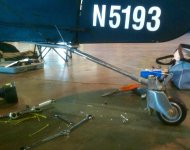plagergren
Member
Two incidents where my RV-8 did a pirouette on the runway/taxiway when I made a) a rudder pulse when hit by a 90 deg crosswind 18 knot gust; b) when I was making a sharp turn on a really narrow taxiway and the tailwheel locking pin disengaged and I went into the lets-do-a-spin-turn mode. So I talked to Van's tech support and they told me "don't use that much rudder" which sounds like a really stupid thing to say because what if you have to use that much? The issue is that the rudder goes +-30-35 degrees and the tailwheel pin unlocks at +- 20 degrees. So how are you supposed to know when you are reaching the rudder travel limits without some kind of rudder travel restrictor while in ground operations? I asked tech support why it was designed that way and they said you have to talk to Van, it's been that way forever and and Van isn't available. Great.
So I have asked multiple experts why the tail wheel locking pin is built this way and no one knows, apparently. Obviously you want to tailwheel to unlock when you are dragging it into the hangar but why do you want the tailwheel to be able to unlock when you are taxiing or taking off? Does anyone have a real answer to that question, in engineering terms and not pilot technique terms?
So I have asked multiple experts why the tail wheel locking pin is built this way and no one knows, apparently. Obviously you want to tailwheel to unlock when you are dragging it into the hangar but why do you want the tailwheel to be able to unlock when you are taxiing or taking off? Does anyone have a real answer to that question, in engineering terms and not pilot technique terms?





